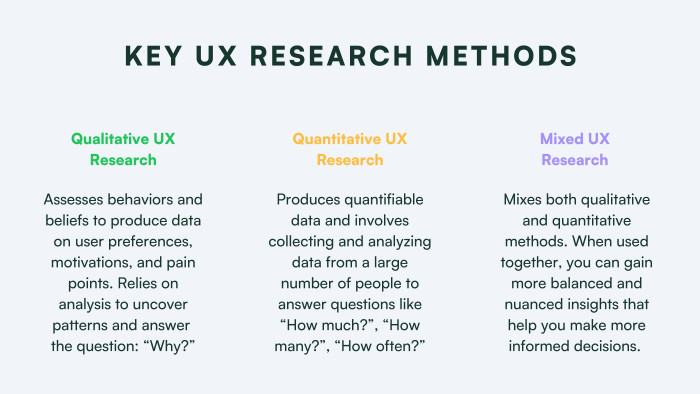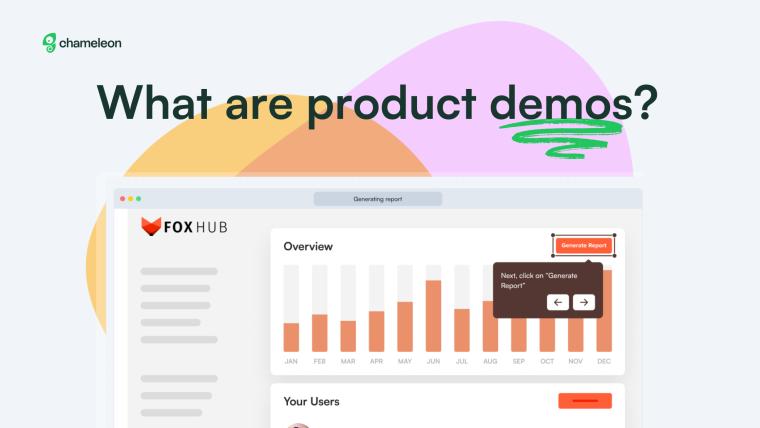The first principle in Google's guiding philosophy is: “Focus on the user and all else will follow.” This statement speaks to the importance of conducting user research. User research is key to designing a product or improving a new or existing user experience. It helps you answer questions like:
Who are the users?
What do they like?
What kind of product or experience do they want?
Why do they want this specific product, design, or feature?
User research can help you shift your focus to a purpose that balances both the users’ needs and your company’s needs—so you shouldn’t treat research as an afterthought.
What is UX research?
The benefits of user research
What does a UX researcher do?
Use this as a starting point to learning about UX research, or dig deeper into the nuances with User Interviews’ UX Research Field Guide, a comprehensive guide to planning, conducting, analyzing, and reporting user insights.
What is UX research?
User experience research is the practice of studying users’ unique intrinsic motivations and desires and discovering actionable insights to improve business strategy, products, and user experiences.
Put in simpler terms, UX research is like baking a cake for a special someone. The cake is the product and your friend is the end user. Before you run out to the store for your ingredients and start kneading the dough, it would be smart to first figure out what kind of cake that person likes.
Do they like chocolate cake or red velvet? Do they want frozen ice cream cake or a special type of frosting? Do they have any allergies? Learning about this person’s cake preferences can help you bake a cake that they are sure to love.
The goal of UX research is to create a product or experience that will make the end user think, “Wow, I needed this product,” or “Wow, I didn’t even know I needed this but this makes my experience 10x better, and easier.”
Qualitative vs. quantitative user research
UX research can take many forms, but the two most common methods are quantitative and qualitative research.
Qualitative UX research assesses behaviors and beliefs to produce data on user preferences, motivations, and pain points. Due to its often subjective nature, qualitative methods ultimately rely on researcher analysis and interpretation to uncover patterns and answer the question: “Why?”
Quantitative UX research produces quantifiable data, aka numbers. It typically involves collecting and analyzing data from a large number of people to unambiguously answer questions like “how much?”, “how many?”, and “how often?”
Mixed methods research is basically mixing both qualitative and quantitative research methods. When used together, you can gain more balanced and nuanced insights that help you make informed decisions.
Other types of user experience research include generative or evaluative, attitudinal or behavioral, and moderated or unmoderated. The type of research method you choose depends on what kind of data you’re looking for.
Regardless of the methodology you choose, the goal of user research is to understand your users better and use those insights to make better decisions and create solutions that ‘wow’ your users.

The benefits of user research
The benefits of user research for your product, business strategy, and your users themselves are manifold. Without user research, we can only make assumptions about what our users really want.
In order to understand whether your product or service is truly relevant, useful, and valuable for your audience, you need user insights.
👇 Here is a quick rundown of some of the advantages of user research.

Let's take a look at each benefit in more detail.
💡 UXR reveals gaps in your knowledge. Oftentimes, we don’t know what we don’t know. And that’s where user research comes in to show us our blind spots and help expand our understanding of our audience.
✅ User insights help you make more informed business decisions. User research serves as the connective tissue between companies’ business goals and user-focused experiences. It’s a practice that balances the users’ needs and wants without sacrificing business performance.
🚀 User research helps you create products and experiences tailored to your users. Whether you’re building a new user journey for your product or improving an existing feature, user research can help guide you in the right direction of addressing your users’ greatest needs.
💸 UX research can help save you time, money, and resources. For example, organizations might introduce a new product or design concept that doesn’t meet user expectations or needs. The cost of launching an ineffective concept that doesn’t serve the users is a loss of time, money, resources, and even additional costs to fix the issue.
The reality of user research is that although it takes time and effort to master the craft of leveraging user insights, it’s an investment that will save your business time and money.
If your organization is not in a place where you can hire an independent team of UX researchers, you can still get started with UX research by learning and implementing research best practices. With the right resources, in-app feedback tools, and people, it’ll become easier to make the most of your UX research and find actionable insights to keep your business on the right track.
What does a UX researcher do?
Now you have a basic understanding of what UX research is. But what does a typical user researcher do?
UX researchers collaborate with designers, product teams, and other stakeholders to uncover user insights and help form better user experiences using this data. According to the User Interviews’ The State of User Research 2022 Report, user researcher roles and responsibilities can look different at various stages of their career and the type of organization they are at.
The main objective of the user researcher’s role is to study and understand users and uncover insights that help other teams (product, design, etc.) make informed decisions.
There are UX researchers (UXRs) and there are people who do research (PwDRs), which include all of the people in an organization engaged in user research activities. This includes designers, product managers, marketers, and more.
Typically, PwDRs move into research to fulfill an immediate business need rather than formally incorporating research into their roles as a continuous duty. UX researchers are solely focused on research and collaborating with PwDRs.
PwDRs can hold varying degrees of operational support for formal researchers because, in all honesty, the demand for UX research can outpace the bandwidth of most research teams. This is where the concept of democratizing research comes into play.
Getting started with UX research can feel like drinking water from a firehose, but the key is to identify how you want to use UX research and how involved or engaged you want certain teams to be with research efforts. Read more about building a company-wide UX research discipline and its importance.
Plus, learn how to use UX research to impact your product strategy from the insights and actionable tactics our guest speakers from User Interviews, Yet Another Studio, and Sketch shared in our UX Research Expert Roundtable. You can watch the whole webinar right here 👇

🎬 UX Research Expert Roundtable
Prefer watching than reading? Watch the whole webinar right here 👇
Getting started with UX research
Not everyone in your organization will become a UX research expert, but the right resources, tools, and people can help you make the most of your UX research and find actionable insights to keep your business on the right track.
Want to learn more about putting user research into practice? Learn how to effectively gather user feedback and apply it to product development. In this article, you’ll find actionable tips and how to create a strategic feedback loop to further improve your product.
Whether you’re in the works of creating the next best B2B SaaS solution or simply looking to improve your overall business strategy, start prioritizing UX research. You’ll find that understanding your users’ intrinsic motivations will empower your organization to achieve your bottom-line goals while addressing your users’ greatest needs.
Get user feedback with Chameleon
Run in-product surveys to collect contextual user feedback throughout the development process – from ideas to validation to deployment.
What is UX Research and Why User Insights are Important
This article is written by Rachell Lee, Content Marketing Manager at User Interviews. As a content writer, marketing enthusiast, and INFJ, she is inspired by humans and their stories. Plus, she spends ridiculous amounts of time on Duolingo and cooking new recipes.





